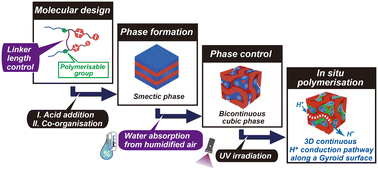Molecular design of a series of gemini-type zwitterionic amphiphiles with various linker lengths: control of their self-organisation for developing gyroid nanostructured proton conductive membranes†
Abstract
The development of advanced proton-conductive membranes is considered a significant challenge in fuel cell technology. To induce high proton conductivity (10−2–10−1 S cm−1), it is important to construct a macroscopically continuous pathway for protons in the membranes. Recently, we successfully created gyroid nanostructured polymer films with a three-dimensional continuous proton conductive pathway, which exhibited high ionic conductivity on the order of 10−5–10−1 S cm−1 depending on the water content. These films were prepared by self-organisation of gemini-type zwitterionic amphiphiles with polymerisable groups into bicontinuous cubic phases in the presence of appropriate amounts of acid, HTf2N, and water, followed by in situ polymerisation. Herein, we investigated the effects of the n values of the –(CH2)n– linker in gemini-type zwitterionic amphiphiles on bicontinuous cubic phases. Results revealed that n = 4–6 was suitable for designing gemini-type zwitterionic amphiphiles that can form bicontinuous cubic phases. Moreover, we successfully developed a new method to change the mesophase pattern of mixtures of these zwitterionic amphiphiles and HTf2N from smectic to bicontinuous cubic phases by placing them under controlled relative humidity conditions. Using this method, a gyroid nanostructured polymer film was successfully obtained from a gemini-type zwitterionic amphiphile with polymerisable groups. A high ionic conductivity of 1.8 × 10−2 S cm−1 was observed when the water content in the film was 13.3 wt%. The present study is expected to provide important insights into the next-generation design of proton-conductive membranes with innovative functions and properties.

- This article is part of the themed collection: Emerging Investigator Series


 Please wait while we load your content...
Please wait while we load your content...